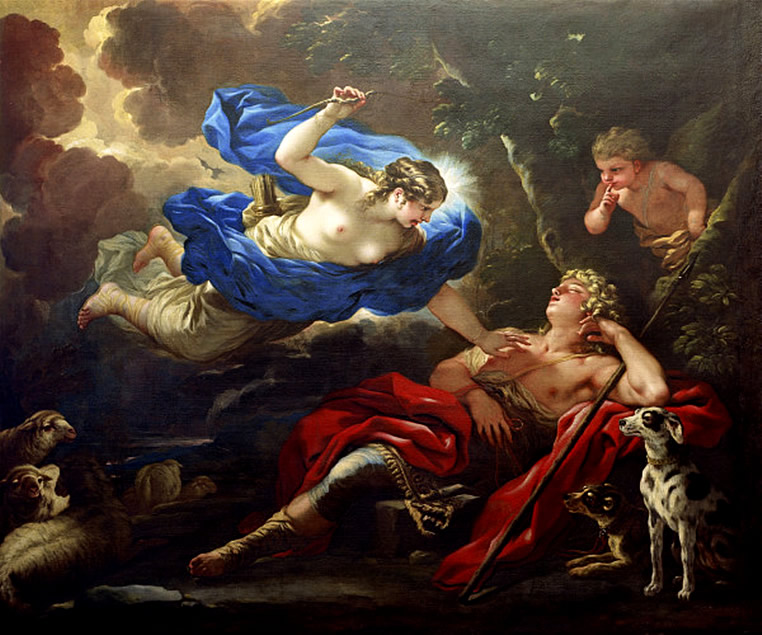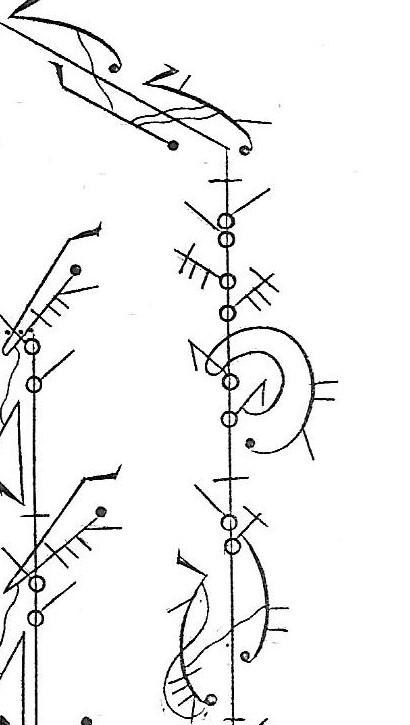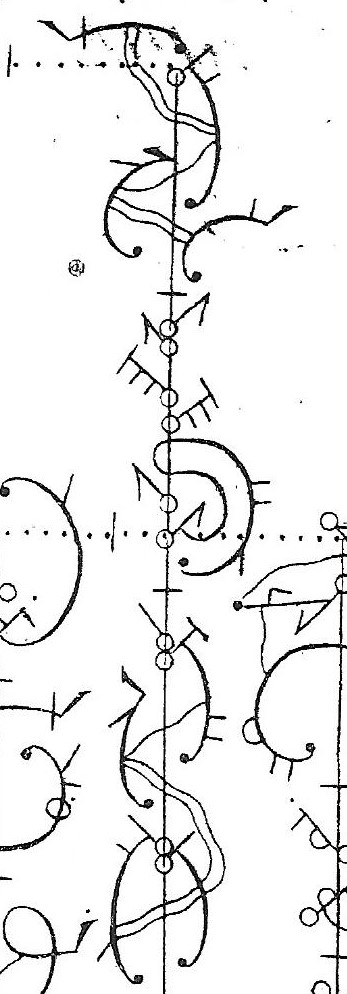Exploring Le Triomphe de l’Amour reminded me how often myths from classical antiquity were exploited for danced entertainments in the late 17th and early 18th centuries. Some classical deities were more popular than others when it came to dancing characters in the ballets de cour – Bacchus appears in six and Flore in five (not counting Le Triomphe de l’Amour), whereas Ariane turns up in just one and Amphitrite does not feature as a dancer at all. I am not going to pursue their earlier appearances here. Instead, I will look at some of the later works given in Paris and London which are based on the characters and myths used in Le Triomphe de l’Amour. I won’t refer to the classical sources for these stories, except to point out that several are included in Ovid’s Metamorphoses – which seems to have been favourite reading at the period.
The first two scenes of Le Triomphe de l’Amour introduce, in turn, Venus and Mars. The god of war is vanquished and enchained in garlands of flowers by Amours, surely in reference to his love affair with the goddess of love which had long been a favourite subject for artists. The story became the theme of a masque in the late 1690s and then an opera, as well as a ballet and a pantomime in the early 1700s. This painting by Nicolas Poussin depicting Mars and Venus dates to 1630.
The masque was The Loves of Mars and Venus by Peter Motteux, with music by Gottfried Finger and John Eccles, given at London’s Lincoln’s Inn Fields Theatre in 1696 within Edward Ravenscroft’s The Anatomist. The title roles were sung by Anne Bracegirdle and John Bowman and there was dancing at the end of the prologue and each act. This comic version is worth further study for its dancing, which I hope to undertake elsewhere. The opera was Les Amours de Mars et de Vénus with music by André Campra and a libretto by Antoine Danchet, given at the Paris Opéra in 1712. This was also a comedy, banned after fourteen performances apparently for its depiction of the cuckolded Vulcain. Mars and Venus were singers, but the dancers in the production included Mlle Guyot (as La Jeunesse in the Prologue) as well as David Dumoulin and Françoise Prévost. The ballet was, of course, John Weaver’s The Loves of Mars and Venus given at London’s Drury Lane Theatre in 1717. I have written about this production elsewhere and I will have more to say in another context. It was answered by the pantomime Mars and Venus; or, The Mouse Trap, performed at Lincoln’s Inn Fields later the same year. The ‘London’ Dupré created the role of Mars in both Weaver’s ballet and the pantomime – the latter was billed as a ‘New Dramatic Entertainment of Dancing in Grotesque Characters’.
Neptune and Amphitrite do not seem to have been taken up by later composers or choreographers, but there was an antecedent to their appearance in Le Triomphe de l’Amour. When The Tempest was fully transformed into a dramatic opera at London’s Dorset Garden Theatre in 1674, it was given a concluding masque centred on them, the singers who took the roles were supported by dancing Tritons. This spectacular production was undoubtedly influenced by dancing and scenic effects in the French theatres, but might it also have influenced Paris? The Tempest became a fixture in the London stage repertoire throughout the 18th century and I will return to it in a later post. This depiction of Neptune and Amphitrite by the French painter Bon Boullogne is dated 1699.
Although Borée and Orithye had featured in the Ballet de l’Impatience of 1661, and Borée certainly turns up in at least one later choreographic context, no other musical works – either operas or ballets – were devoted to their story, so far as I know. This sculpture by Gaspard Marsy and Anselme Flamen was created between 1677 and 1687.
After Le Triomphe de l’Amour, the love story of Diane and Endymion was not taken up on the French stage until 1731, when the opera Endymion with music by François Colin de Blamont and a libretto by Bernard Le Bovier de Fontenelle was given at the Paris Opéra. It lasted for only a few performances, despite a cast of supporting dancers that included David Dumoulin, Marie-Anne de Camargo and ‘le grand’ Dupré. In London, Drury Lane had offered a production that drew on the myth as early as 1696. Thomas Durfey’s dramatic opera Cinthia and Endimion was given there that year and may have first been written some ten years earlier, for a performance at the court of Charles II that did not materialise. It featured not only Diana and Endymion but also Cupid and Psyche, Apollo and Daphne and Pan and Syrinx, as well as Neptune and Amphitrite, Zephyrus and Mercury. A link to Le Triomphe de l’Amour, while unlikely, is not impossible. Much later, in 1736, Endymion reappeared in the Covent Garden pantomime The Royal Chace, another work which is worth a closer look in a later post. Here, Diane and Endymion are depicted by Luca Giordano around 1680.
Bacchus and Ariane were depicted in the unsuccessful 1696 opera Ariadne et Bacchus by Marin Marais. The dancers were not named in the accompanying livret by Saint-Jean, so we have no idea who they were. The myth was more famously interpreted at London’s Covent Garden Theatre in 1734, when Malter and Marie Sallé danced as Bacchus and Ariadne in a ballet initially inserted into the pantomime The Necromancer and later given as an entr’acte entertainment. Eustache Le Sueur painted Bacchus and Ariane around 1640.
The last classical love story in Le Triomphe de l’Amour was that of Zéphire and Flore, which became an opera by Louis and Jean-Louis Lully in 1688. No dancers were named for the performances at that period, but when it was revived at the Paris Opéra in 1715 the leading dancers were David Dumoulin, Mlle Guyot and Mlle Prévost. As I have mentioned elsewhere, Zephyrus and Flora were the central characters in the divertissement which ended the 1726 Lincoln’s Inn Fields pantomime Apollo and Daphne. This elaborate scene may well have been adapted (or directly copied) from a divertissement in Jacques Aubert’s La Reine des Péris given at the Paris Opéra in 1725. Jacopo Amigoni depicted Zephyr and Flore in the 1730s, probably for an English patron.
These various stage versions of the love stories that were part of Le Triomphe de l’Amour, together with the painting and sculpture of the 17th and 18th centuries, show how deeply both the English and the French were immersed in the myths of classical antiquity. The court and theatre dance which was part of this culture, well before the advent of the ballet d’action, is all too often overlooked.





























